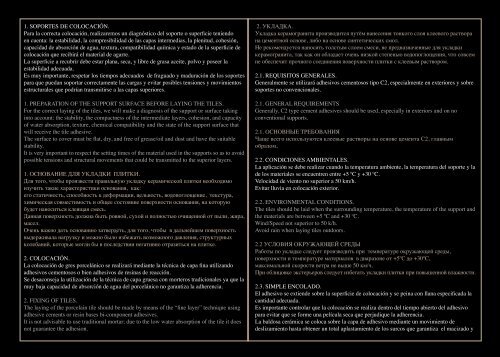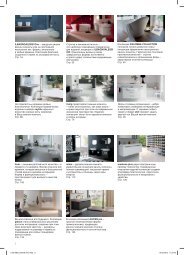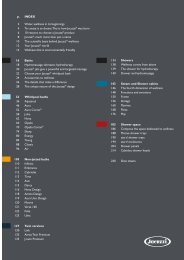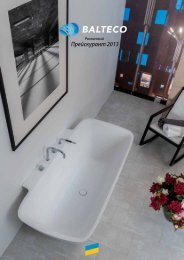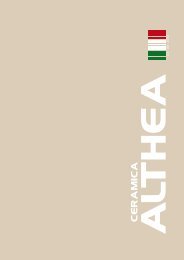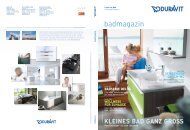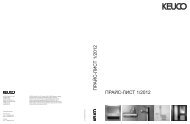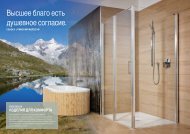Create successful ePaper yourself
Turn your PDF publications into a flip-book with our unique Google optimized e-Paper software.
1. SOPORTES DE COLOCACIÓN.<br />
Para la correcta colocación, realizaremos un diagnóstico del soporte o superficie teniendo<br />
en cuenta: la estabilidad, la compresibilidad de las capas intermedias, la plenitud, cohesión,<br />
capacidad de absorción de agua, textura, compatibilidad química y estado de la superficie de<br />
colocación que recibirá el material de agarre.<br />
La superficie a recubrir debe estar plana, seca, y libre de grasa aceite, polvo y poseer la<br />
estabilidad adecuada.<br />
Es muy importante, respetar los tiempos adecuados de fraguado y maduración de los soportes<br />
para que puedan soportar correctamente las cargas y evitar posibles tensiones y movimientos<br />
estructurales que podrían transmitirse a las capas superiores.<br />
1. PREPARATION OF THE SUPPORT SURFACE BEFORE LAYING THE TILES.<br />
For the correct laying of the tiles, we will make a diagnosis of the support or surface taking<br />
into account: the stability, the compactness of the intermediate layers, cohesion, and capacity<br />
of water absorption, texture, chemical compatibility and the state of the support surface that<br />
will receive the tile adhesive.<br />
The surface to cover must be flat, dry, and free of grease/oil and dust and have the suitable<br />
stability.<br />
It is very important to respect the setting times of the material used in the supports so as to avoid<br />
possible tensions and structural movements that could be transmitted to the superior layers.<br />
1. ОСНОВАНИЕ ДЛЯ УКЛАДКИ ПЛИТКИ.<br />
Для того, чтобы произвести правильную укладку керамической плитки необходимо<br />
изучить такие характеристики основания, как:<br />
его статичность, способность к деформации, цельность, водопоглощение, текстура,<br />
химическая совместимость и общее состояние поверхности основания, на которую<br />
будет наноситься клеящая смесь.<br />
Данная поверхность должна быть ровной, сухой и полностью очищенной от пыли, жира,<br />
масел.<br />
Очень важно дать основанию затвердеть, для того, чтобы в дальнейшем поверхность<br />
выдерживала нагрузку и можно было избежать возможного давления, структурных<br />
колебаний, которые могли бы в последствии негативно отразиться на плитке.<br />
2. COLOCACIÓN.<br />
La colocación de gres porcelánico se realizará mediante la técnica de capa fina utilizando<br />
adhesivos cementosos o bien adhesivos de resinas de reacción.<br />
Se desaconseja la utilización de la técnica de capa gruesa con morteros tradicionales ya que la<br />
muy baja capacidad de absorción de agua del porcelánico no garantiza la adherencia.<br />
2. FIXING OF TILES.<br />
The laying of the porcelain tile should be made by means of the “fine layer” technique using<br />
adhesive cements or resin bases bi-component adhesives.<br />
It is not advisable to use traditional mortar; due to the low water absorption of the tile it does<br />
not guarantee the adhesion.<br />
2. УКЛАДКА.<br />
Укладка керамогранита производится путём нанесения тонкого слоя клеевого раствора<br />
на цементной основе, либо на основе синтетических смол.<br />
Не рекомендуется наносить толстым слоем смеси, не предназначенные для укладки<br />
керамогранита, так как он обладает очень низкой степенью водопоглощения, что совсем<br />
не обеспечит прочного соединения поверхности плитки с клеевым раствором.<br />
2.1. REQUISITOS GENERALES.<br />
Generalmente se utilizará adhesivos cementosos tipo C2, especialmente en exteriores y sobre<br />
soportes no convencionales.<br />
2.1. GENERAL REQUIREMENTS<br />
Generally, C2 type cement adhesives should be used, especially in exteriors and on no<br />
conventional supports.<br />
2.1. ОСНОВНЫЕ ТРЕБОВАНИЯ<br />
Чаще всего используются клеевые растворы на основе цемента С2, главным<br />
образом,<br />
2.2. CONDICIONES AMBIENTALES.<br />
La aplicación se debe realizar cuando la temperatura ambiente, la temperatura del soporte y la<br />
de los materiales se encuentren entre +5 ºC y +30 ºC.<br />
Velocidad de viento no superior a 50 km/h.<br />
Evitar lluvia en colocación exterior.<br />
2.2. ENVIRONMENTAL CONDITIONS.<br />
The tiles should be laid when the surrounding temperature, the temperature of the support and<br />
the materials are between +5 ºC and +30 ºC.<br />
Wind/Speed not superior to 50 k/h.<br />
Avoid rain when laying tiles outdoors.<br />
2.2 УСЛОВИЯ ОКРУЖАЮЩЕЙ СРЕДЫ<br />
Работы по укладке следует производить при температуре окружающей среды,<br />
поверхности и температуре материалов в диаразоне от +5ºС до +30ºС,<br />
максимальной скорости ветра не выше 50 км/ч.<br />
При облицовке экстерьеров следует избегать укладки плитки при повышенной влажности.<br />
2.3. SIMPLE ENCOLADO.<br />
El adhesivo se extiende sobre la superficie de colocación y se peina con llana especificada la<br />
cantidad adecuada.<br />
Es importante controlar que la colocación se realiza dentro del tiempo abierto del adhesivo<br />
para evitar que se forme una película seca que perjudique la adherencia.<br />
La baldosa cerámica se coloca sobre la capa de adhesivo mediante un movimiento de<br />
deslizamiento hasta obtener un total aplastamiento de los surcos que garantiza el macizado y


